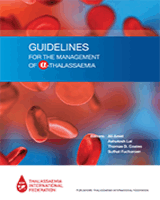From: Chapter 1, EPIDEMIOLOGY, PATHOPHYSIOLOGY AND DIAGNOSIS OF α-THALASSAEMIA

NCBI Bookshelf. A service of the National Library of Medicine, National Institutes of Health.
The phenotypic severity of HbH disease does not merely correlate with the degree of α-chain deficiency. HbH has very high oxygen affinity, making it unable to efficiently deliver oxygen to the body’s tissues. Additionally, HbH is relatively unstable, which leads to its precipitation within red blood cells. These precipitated cells are then prematurely destroyed in the spleen, resulting in moderate extravascular hemolysis and anaemia. When compared to β-thalassaemias, the underlying pathophysiology of most forms of HbH disease primarily involves peripheral hemolysis, with a lesser degree of ineffective erythropoiesis.
HbH disease exhibits significant variability in clinical and hematological severity. Typically, patients with deletional HbH disease, resulting from deletional mutations, maintain good health and often do not require treatment. However, in rare instances, red blood cell transfusions may become necessary if there is a sudden drop in haemoglobin levels, especially during pregnancy or due to acute haemolytic or aplastic events triggered primarily by viral infections.
From: Chapter 1, EPIDEMIOLOGY, PATHOPHYSIOLOGY AND DIAGNOSIS OF α-THALASSAEMIA

NCBI Bookshelf. A service of the National Library of Medicine, National Institutes of Health.